Commercial Ice Cream Freezer Guide
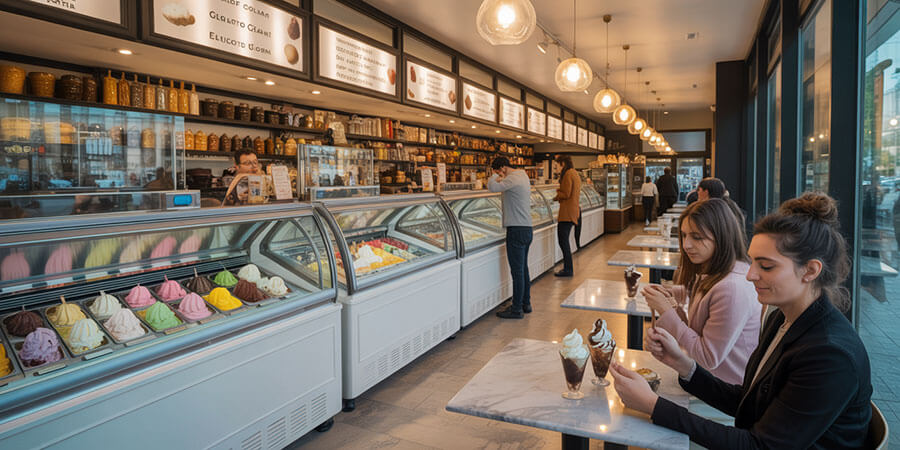
Table of Contents
Everything you need to know about choosing ice cream freezers and frozen dessert equipment for your business
Frozen Dessert Success Starts Here
The Business Case for Frozen Desserts
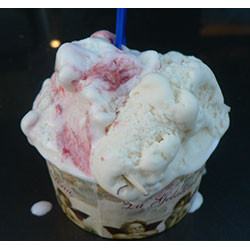
Frozen desserts represent a $10+ billion industry in the United States alone, with commercial ice cream freezers playing a crucial role in maintaining product quality and profitability. Whether you're a restaurant owner looking to boost dessert sales, an ice cream shop operator focused on premium service, or a grocery store manager aiming to increase impulse purchases, the right freezer equipment can be the difference between mediocre results and outstanding success.
Modern commercial freezers go beyond simple cold storage - they provide precise temperature control, optimal humidity levels, and features designed specifically for frozen desserts. This specialized equipment ensures that your ice cream maintains its perfect texture, your gelato stays scoopably soft, and your frozen yogurt remains consistently creamy.
Revenue Potential Across Business Types
Restaurants & Cafes:
Frozen desserts can increase check averages by 15-25% while requiring minimal additional staff time. A single ice cream freezer can generate $50-$200 in daily revenue depending on location and menu positioning.
Ice Cream Shops:
These businesses rely entirely on frozen dessert sales, with successful operations generating $300-$1,000+ in daily revenue. The right freezer equipment can mean the difference between a thriving business and one struggling with product quality issues.
Grocery Stores & Convenience Stores:
Frozen dessert sections can significantly boost impulse purchases and increase overall store traffic. Well-maintained freezers keep products appealing and drive repeat customer visits.
Common Challenges Without Proper Equipment
- Ice Crystal Formation: Improper storage temperatures cause ice crystals that ruin texture
- Flavor Degradation: Incorrect temperatures allow flavors to break down over time
- Product Waste: Spoiled inventory reduces profitability
- Customer Dissatisfaction: Poor quality leads to lost business and negative reviews
Understanding Ice Cream Freezer Categories
Different frozen dessert operations require different types of freezer equipment. Each category serves specific business needs and customer service styles. Here's an overview of the main categories available:
Dipping Cabinets: Traditional Hand-Scooped Service
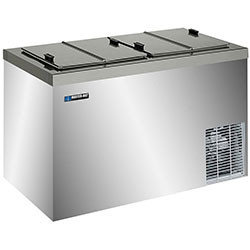
Dipping cabinets remain the most popular choice for businesses offering traditional hand-scooped ice cream service. These upright freezers feature glass doors that allow customers to view available flavors while keeping products at optimal serving temperatures.
The design of dipping cabinets has evolved significantly from traditional models. Modern units feature advanced temperature management systems that maintain consistent conditions across all shelves, ensuring that every flavor is served at its optimal temperature. Many models include digital controls for easy monitoring and adjustment, while others offer programmable settings for different times of day or seasonal variations.
Beyond basic storage, contemporary dipping cabinets often include features like LED lighting to enhance product visibility, antimicrobial surfaces for improved sanitation, and energy-efficient compressors that reduce operating costs. These advancements make modern dipping cabinets not just storage solutions, but valuable marketing tools that help drive impulse purchases and enhance the overall customer experience.
Key Features:
- Glass front for product visibility and easy customer selection
- Interior access from the back for staff serving
- Multiple shelves to organize different flavors
- Temperature range of -10°F to 0°F for perfect scooping consistency
Best For:
- Ice cream parlors and dessert-focused restaurants
- Businesses emphasizing premium, hand-scooped service
- Operations serving multiple ice cream varieties
Capacity Options:
- Small: 3-6 tubs (perfect for cafes and small restaurants)
- Medium: 8-12 tubs (ideal for mid-size ice cream shops)
- Large: 15-39 tubs (designed for high-volume operations)
Gelato Dipping Cabinets: Specialized for Italian-Style Desserts
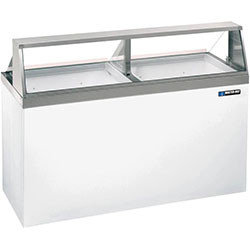
Gelato requires different storage conditions than traditional ice cream due to its softer texture and different formulation. Gelato dipping cabinets are specifically designed to maintain the perfect temperature for this Italian-style frozen dessert.
The art of gelato-making demands precision that goes beyond traditional ice cream storage. Modern gelato cabinets incorporate sophisticated climate control systems that maintain the ideal humidity levels essential for preserving gelato's signature smoothness. Advanced models feature programmable temperature zones that can accommodate both gelato and traditional ice cream simultaneously, making them versatile solutions for businesses offering multiple frozen dessert options.
Italian artisans have long understood that gelato's quality depends on more than just temperature - humidity control prevents the formation of unwanted ice crystals that can ruin texture. Contemporary gelato cabinets often include built-in humidification systems and specialized shelving designed to maximize air circulation around each gelato pan, ensuring consistent quality across all flavors and preventing the drying out that can occur with inferior storage solutions.
Key Features:
- Optimized temperature range for gelato's softer consistency
- Specialized shelving designed for gelato pans
- Humidity control to prevent drying out
- Temperature typically maintained at 0°F to -5°F
Best For:
- Authentic gelaterias and Italian restaurants
- Businesses specializing in artisanal frozen desserts
- Operations that want to offer both gelato and traditional ice cream
Glass-Top Display Freezers: Perfect for Impulse Purchases
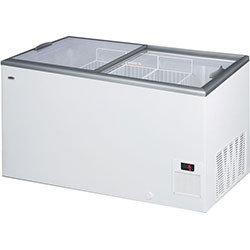
Glass-top display freezers excel at showcasing pre-packaged frozen treats and driving impulse purchases. These versatile units work well in grocery stores, convenience stores, and any location where customers browse and select their own items.
The psychology of impulse purchasing is built into the design of glass-top display freezers. These units create an irresistible visual display that encourages customers to browse and select items they hadn't originally planned to purchase. Modern models incorporate strategic lighting systems that highlight product colors and textures, while curved glass designs provide optimal viewing angles from multiple directions.
Beyond basic display functionality, contemporary glass-top freezers include features like adjustable shelving heights to accommodate different product packaging, removable trays for easy cleaning and restocking, and temperature controls that can be fine-tuned for different types of frozen novelties. Some advanced models even include built-in lighting timers that can create eye-catching displays during peak shopping hours while conserving energy during slower periods.
Key Features:
- Large glass top surface for product display
- Multiple shelves for organizing different items
- Self-service design encourages browsing
- Temperature range of -10°F to 10°F depending on products
Best For:
- Grocery stores and convenience stores
- Businesses selling packaged frozen novelties
- Self-service dessert stations
- High-traffic locations where impulse purchases are common
Common Applications:
- Ice cream sandwiches and bars
- Frozen yogurt cups
- Sorbet and fruit-based frozen treats
- Pre-packaged desserts
Commercial Chest Freezers: Reliable Storage Solutions

Chest freezers provide excellent storage capacity and energy efficiency for businesses that need to store large quantities of frozen desserts. While not ideal for customer-facing service, they excel at maintaining consistent temperatures for bulk storage.
Chest freezers represent the pinnacle of energy efficiency in commercial refrigeration, with many models achieving ENERGY STAR certification through advanced insulation technologies and high-efficiency compressors. The horizontal design naturally retains cold air better than upright models, reducing energy consumption by up to 40% compared to traditional reach-in freezers. This efficiency translates directly to lower operating costs and improved profitability for cost-conscious operations.
Modern chest freezers incorporate smart features like digital temperature monitoring, automatic defrost cycles, and heavy-duty casters for easy repositioning. The deep storage capacity allows businesses to maintain larger inventories while minimizing the frequency of restocking, and the organized storage baskets help prevent product mixing and maintain optimal organization even in high-volume environments.
Key Features:
- Excellent insulation for stable temperatures
- Large storage capacity in a compact footprint
- Energy-efficient operation
- Reliable performance for continuous use
Best For:
- Back-of-house storage and preparation
- Businesses with limited customer-facing space
- Bulk storage needs
- Cost-conscious operations
Soft-Serve & Gelato Machines: Modern Frozen Dessert Service

Soft-serve machines and gelato machines offer a different approach to frozen dessert service, producing frozen desserts on-demand rather than storing pre-made products.
The evolution of soft-serve technology has transformed how businesses approach frozen dessert service. Modern machines incorporate sophisticated air-pumping systems that create the perfect overrun (the amount of air incorporated into the product), resulting in lighter, more profitable servings. Advanced models feature touchscreen controls, portion control systems, and the ability to switch between different product consistencies with a simple button press.
Quality soft-serve machines maintain precise temperature control throughout the entire dispensing system, ensuring that product remains at the ideal serving consistency from the first customer to the last. Many contemporary models include built-in cleaning systems that automate the sanitation process, reducing labor requirements and ensuring consistent hygiene standards that are crucial for food service operations.
Key Features:
- On-demand production eliminates storage concerns
- Consistent product quality and portion control
- Wide variety of flavor options
- Self-serve or assisted-service models available
Best For:
- Quick-service restaurants and fast-casual operations
- Businesses focused on efficiency and consistency
- High-volume dessert service
- Modern dessert concepts
Cold Slab & Frost Top Units: Countertop Service Solutions
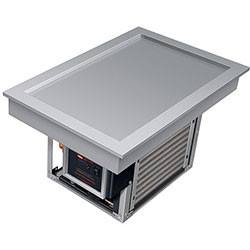
Cold slabs and frost tops provide a convenient countertop solution for serving frozen desserts. These units offer a chilled surface for mixing toppings and serving ice cream without requiring a full freezer unit.
Cold slabs and frost tops have become essential tools for modern dessert presentation, offering a hygienic and efficient alternative to traditional ice cream tubs. The chilled granite or stainless steel surface maintains the perfect temperature for extended service periods without the mess and sanitation concerns associated with ice baths. Modern units often include built-in drainage systems and easy-to-clean surfaces that meet commercial kitchen sanitation standards.
These countertop units excel in high-volume environments where speed and efficiency are paramount. The large surface area allows servers to work quickly during peak periods, while the consistent chilling ensures that ice cream remains scoopable and toppings stay fresh. Some advanced models include built-in storage compartments for toppings and supplies, creating a complete dessert service station in a compact footprint that maximizes valuable counter space.
Key Features:
- Countertop design saves valuable floor space
- Chilled surface for mixing toppings
- Easy to clean and maintain
- Perfect for limited-space operations
Best For:
- Countertop dessert service
- Businesses with limited floor space
- Quick topping and mixing operations
- Supplement to existing freezer equipment
Temperature Requirements for Different Frozen Desserts
Maintaining the correct temperature is crucial for preserving the quality, texture, and flavor of frozen desserts. Different products require different storage conditions:
| Frozen Dessert Type: | Storage Temperature: | Serving Temperature: | Shelf Life (Opened): | Shelf Life (Unopened): |
| Traditional Ice Cream | -10°F to -20°F | -5°F to 5°F | 1-2 months | 2-3 months |
| Gelato | 0°F to -5°F | 15°F to 20°F | 2 weeks | 1-2 months |
| Frozen Yogurt | -10°F to -15°F | 0°F to 10°F | 2-4 weeks | 1-2 months |
| Sorbet | -5°F to 0°F | 10°F to 15°F | 1-2 months | 2-4 months |
| Soft-Serve Mix | 35°F to 40°F (before freezing) | N/A | 7-10 days | 2-3 months |
Why Temperature Matters
Texture Preservation:
Incorrect temperatures cause ice crystals to form, ruining the smooth texture that customers expect from premium frozen desserts.
Flavor Integrity:
Frozen desserts contain delicate flavor compounds that can break down at improper temperatures, resulting in bland or off-flavored products.
Food Safety:
Maintaining proper temperatures prevents bacterial growth and ensures product safety for consumption.
Business Applications and Menu Integration
Restaurant Integration Strategies
Dessert-Only Restaurants:
These businesses rely entirely on frozen desserts for revenue. Equipment selection focuses on customer-facing display and quick service to maximize impulse purchases.
Full-Service Restaurants:
Adding frozen desserts to an existing menu requires equipment that complements the main dining experience. Consider how dessert service fits into your overall service flow.
Quick-Service Restaurants:
Fast-casual and QSR operations benefit from equipment that supports quick service and high turnover. Soft-serve machines and efficient dipping cabinets work well in these environments.
Grocery Store Applications
In-Store Dessert Sections:
Glass-top display freezers create dedicated frozen dessert areas that drive impulse purchases and increase overall store traffic.
Prepared Foods Integration:
Chest freezers in prepared foods sections allow grocery stores to offer premium frozen desserts alongside other prepared items.
Seasonal Promotions:
Proper freezer equipment enables grocery stores to offer seasonal frozen treats and limited-edition flavors.
Operational Considerations
Space Planning:
Consider both floor space and customer flow when selecting freezer equipment. Ensure adequate clearance for cleaning and maintenance.
Staff Training:
Different freezer types require different operational procedures. Plan for staff training on proper temperature monitoring and product handling.
Maintenance Requirements:
Regular defrosting, cleaning, and temperature calibration are essential for maintaining product quality and equipment longevity.
Cost Analysis and ROI Considerations
Initial Investment Ranges
| Equipment Category: | Entry Level: | Mid-Range: | Premium: |
| Dipping Cabinets | $2,500-$4,000 | $4,000-$7,000 | $7,000-$15,000+ |
| Gelato Cabinets | $3,000-$5,000 | $5,000-$8,000 | $8,000-$12,000+ |
| Glass-Top Displays | $1,500-$3,000 | $3,000-$5,000 | $5,000-$8,000+ |
| Chest Freezers | $800-$2,000 | $2,000-$4,000 | $4,000-$6,000+ |
| Soft-Serve Machines | $5,000-$8,000 | $8,000-$15,000 | $15,000-$25,000+ |
| Cold Slabs | $500-$1,500 | $1,500-$3,000 | $3,000-$5,000+ |
Operating Cost Factors
Energy Consumption:
- Glass-front units consume more energy due to frequent door opening
- Chest freezers are typically the most energy-efficient
- Consider local utility rates when calculating ongoing costs
Maintenance Expenses:
- Professional servicing: $200-$500 annually
- Parts replacement: $100-$300 annually
- Cleaning supplies: $50-$150 annually
Revenue Projections
Daily Revenue Potential:
- Small cafe: $50-$150 from frozen desserts
- Ice cream shop: $300-$800 from frozen desserts
- Grocery store section: $100-$400 in incremental sales
- Restaurant addition: $75-$250 in dessert sales
Profit Margin Analysis:
- Traditional ice cream: 60-70% profit margin
- Premium gelato: 65-75% profit margin
- Soft-serve: 70-80% profit margin
- Frozen novelties: 50-65% profit margin
Break-Even Analysis
Example: Ice Cream Dipping Cabinet
- Equipment cost: $5,000
- Daily revenue increase: $150
- Daily profit: $90 (60% margin)
- Payback period: Approximately 2 months
- Annual ROI: 216%
Equipment Selection Guide by Business Type
For Ice Cream Parlors and Dessert Shops
Recommended Equipment: Large dipping cabinets with multiple flavor capacity
Key Considerations: Customer visibility, quick service, premium presentation
Additional Needs: Scoops, bowls, toppings station
For Restaurants Adding Desserts
Recommended Equipment: Medium dipping cabinet or cold slab unit
Key Considerations: Space limitations, menu integration, staff efficiency
Additional Needs: Dessert plates, garnishes, portion control
For Grocery Stores and Convenience Stores
Recommended Equipment: Glass-top display freezers and chest freezers
Key Considerations: Product variety, impulse purchasing, maintenance access
Additional Needs: Packaging, pricing signs, cleaning supplies
For Quick-Service Operations
Recommended Equipment: Soft-serve machines or efficient dipping cabinets
Key Considerations: Speed of service, consistency, high turnover
Additional Needs: Portion control, cleaning efficiency
Essential Accessories and Supplies
Serving Essentials
- Commercial ice cream scoops in various sizes
- Portion control dishes and bowls
- Sprinkles, sauces, and topping stations
- Sneeze guards for sanitary service
Maintenance Tools
Digital thermometers for temperature monitoring
Defrosting tools and scrapers
Food-safe cleaning supplies
Replacement gaskets and seals
Storage Solutions
- Ice cream tubs and containers
- Flavor organization systems
- Date labeling systems
- Inventory tracking tools
Future Expansion Opportunities
As your frozen dessert program grows, consider these specialized guides for deeper dives into specific equipment categories:
- Dipping Cabinet Selection Guide - Detailed comparison of ice cream and gelato cabinets
- Soft-Serve Machine Buying Guide - Equipment selection for modern frozen dessert service
- Glass-Top Display Freezer Guide - Optimizing impulse purchase displays
- Frozen Dessert Storage Best Practices - Advanced temperature management and inventory control
Frequently Asked Questions
What's the difference between ice cream freezers and regular commercial freezers?
Ice cream freezers are specifically designed to maintain the precise temperatures needed for frozen desserts (-10°F to 0°F), with features like glass doors for product visibility and specialized shelving. Regular commercial freezers maintain colder temperatures (-10°F to -20°F) and are designed for long-term storage rather than frequent access.
How often should I defrost my ice cream freezer?
Most ice cream freezers have automatic defrost cycles, but manual defrosting may be needed 1-2 times per year depending on usage and model. Always follow manufacturer guidelines to prevent temperature fluctuations that could affect product quality.
Q: Can I store different types of frozen desserts in the same freezer?
While technically possible, it's not recommended because different frozen desserts require different storage temperatures. Ice cream needs colder temperatures than gelato, and storing them together can compromise texture and quality.
What's the most energy-efficient type of ice cream freezer?
Chest freezers are generally the most energy-efficient due to their excellent insulation and lid design that minimizes cold air loss. However, consider your specific needs - if customer visibility is important, a glass-front dipping cabinet might be worth the slightly higher energy costs.
How do I know what size freezer I need?
Calculate based on your expected daily servings and product variety. A small cafe might need a 6-tub dipping cabinet, while a busy ice cream shop could require 20-30 tubs. Consider both current needs and future growth when making your selection.
Shop Ice Cream Freezer Equipment
Ready to add frozen desserts to your menu? Browse our complete selection of ice cream freezers and equipment:
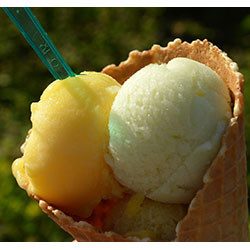
- [Ice Cream Dipping Cabinets] - Traditional hand-scooped service solutions
- [Gelato Dipping Cabinets] - Specialized equipment for Italian-style desserts
- [Glass Top Display Freezers] - Perfect for impulse purchases and self-service
- [Commercial Chest Freezers] - Reliable storage and bulk capacity
- [Soft-Serve Ice Cream Machines] - Modern frozen dessert production
- [Cold Slab & Frost Top Units] - Countertop serving solutions
Need help choosing the right equipment for your business? Contact our frozen dessert specialists for personalized recommendations based on your menu, space, and budget requirements.
This comprehensive guide provides everything you need to know about selecting ice cream freezers for your business. Whether you're opening a new ice cream shop, adding desserts to your restaurant menu, or expanding your grocery store offerings, the right freezer equipment ensures product quality and customer satisfaction.
Share This!